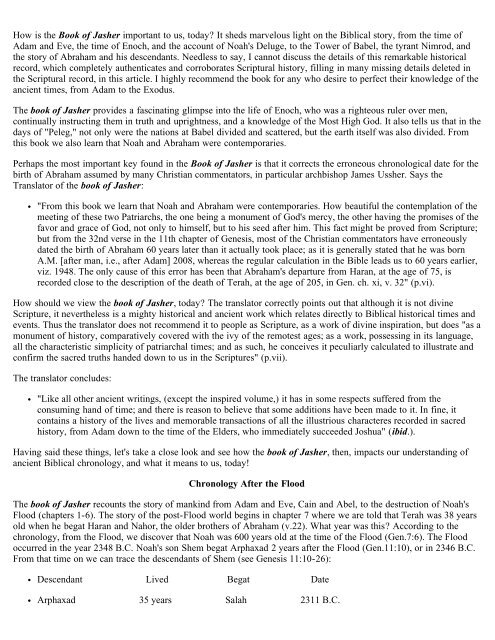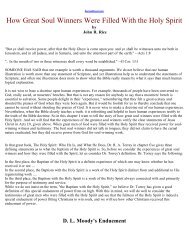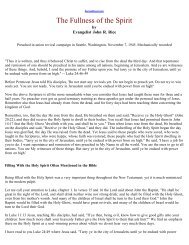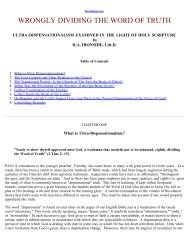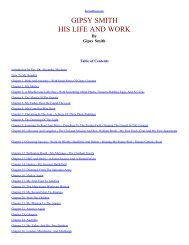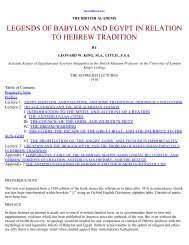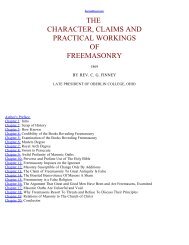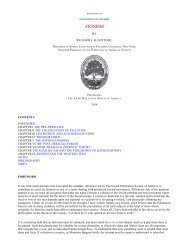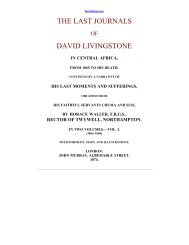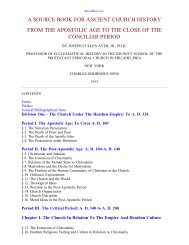The Book of Jasher.pdf - Bennie Blount.com
The Book of Jasher.pdf - Bennie Blount.com
The Book of Jasher.pdf - Bennie Blount.com
You also want an ePaper? Increase the reach of your titles
YUMPU automatically turns print PDFs into web optimized ePapers that Google loves.
How is the <strong>Book</strong> <strong>of</strong> <strong>Jasher</strong> important to us, today? It sheds marvelous light on the Biblical story, from the time <strong>of</strong><br />
Adam and Eve, the time <strong>of</strong> Enoch, and the account <strong>of</strong> Noah's Deluge, to the Tower <strong>of</strong> Babel, the tyrant Nimrod, and<br />
the story <strong>of</strong> Abraham and his descendants. Needless to say, I cannot discuss the details <strong>of</strong> this remarkable historical<br />
record, which <strong>com</strong>pletely authenticates and corroborates Scriptural history, filling in many missing details deleted in<br />
the Scriptural record, in this article. I highly re<strong>com</strong>mend the book for any who desire to perfect their knowledge <strong>of</strong> the<br />
ancient times, from Adam to the Exodus.<br />
<strong>The</strong> book <strong>of</strong> <strong>Jasher</strong> provides a fascinating glimpse into the life <strong>of</strong> Enoch, who was a righteous ruler over men,<br />
continually instructing them in truth and uprightness, and a knowledge <strong>of</strong> the Most High God. It also tells us that in the<br />
days <strong>of</strong> "Peleg," not only were the nations at Babel divided and scattered, but the earth itself was also divided. From<br />
this book we also learn that Noah and Abraham were contemporaries.<br />
Perhaps the most important key found in the <strong>Book</strong> <strong>of</strong> <strong>Jasher</strong> is that it corrects the erroneous chronological date for the<br />
birth <strong>of</strong> Abraham assumed by many Christian <strong>com</strong>mentators, in particular archbishop James Ussher. Says the<br />
Translator <strong>of</strong> the book <strong>of</strong> <strong>Jasher</strong>:<br />
"From this book we learn that Noah and Abraham were contemporaries. How beautiful the contemplation <strong>of</strong> the<br />
meeting <strong>of</strong> these two Patriarchs, the one being a monument <strong>of</strong> God's mercy, the other having the promises <strong>of</strong> the<br />
favor and grace <strong>of</strong> God, not only to himself, but to his seed after him. This fact might be proved from Scripture;<br />
but from the 32nd verse in the 11th chapter <strong>of</strong> Genesis, most <strong>of</strong> the Christian <strong>com</strong>mentators have erroneously<br />
dated the birth <strong>of</strong> Abraham 60 years later than it actually took place; as it is generally stated that he was born<br />
A.M. [after man, i.e., after Adam] 2008, whereas the regular calculation in the Bible leads us to 60 years earlier,<br />
viz. 1948. <strong>The</strong> only cause <strong>of</strong> this error has been that Abraham's departure from Haran, at the age <strong>of</strong> 75, is<br />
recorded close to the description <strong>of</strong> the death <strong>of</strong> Terah, at the age <strong>of</strong> 205, in Gen. ch. xi, v. 32" (p.vi).<br />
How should we view the book <strong>of</strong> <strong>Jasher</strong>, today? <strong>The</strong> translator correctly points out that although it is not divine<br />
Scripture, it nevertheless is a mighty historical and ancient work which relates directly to Biblical historical times and<br />
events. Thus the translator does not re<strong>com</strong>mend it to people as Scripture, as a work <strong>of</strong> divine inspiration, but does "as a<br />
monument <strong>of</strong> history, <strong>com</strong>paratively covered with the ivy <strong>of</strong> the remotest ages; as a work, possessing in its language,<br />
all the characteristic simplicity <strong>of</strong> patriarchal times; and as such, he conceives it peculiarly calculated to illustrate and<br />
confirm the sacred truths handed down to us in the Scriptures" (p.vii).<br />
<strong>The</strong> translator concludes:<br />
"Like all other ancient writings, (except the inspired volume,) it has in some respects suffered from the<br />
consuming hand <strong>of</strong> time; and there is reason to believe that some additions have been made to it. In fine, it<br />
contains a history <strong>of</strong> the lives and memorable transactions <strong>of</strong> all the illustrious characteres recorded in sacred<br />
history, from Adam down to the time <strong>of</strong> the Elders, who immediately succeeded Joshua" (ibid.).<br />
Having said these things, let's take a close look and see how the book <strong>of</strong> <strong>Jasher</strong>, then, impacts our understanding <strong>of</strong><br />
ancient Biblical chronology, and what it means to us, today!<br />
Chronology After the Flood<br />
<strong>The</strong> book <strong>of</strong> <strong>Jasher</strong> recounts the story <strong>of</strong> mankind from Adam and Eve, Cain and Abel, to the destruction <strong>of</strong> Noah's<br />
Flood (chapters 1-6). <strong>The</strong> story <strong>of</strong> the post-Flood world begins in chapter 7 where we are told that Terah was 38 years<br />
old when he begat Haran and Nahor, the older brothers <strong>of</strong> Abraham (v.22). What year was this? According to the<br />
chronology, from the Flood, we discover that Noah was 600 years old at the time <strong>of</strong> the Flood (Gen.7:6). <strong>The</strong> Flood<br />
occurred in the year 2348 B.C. Noah's son Shem begat Arphaxad 2 years after the Flood (Gen.11:10), or in 2346 B.C.<br />
From that time on we can trace the descendants <strong>of</strong> Shem (see Genesis 11:10-26):<br />
Descendant Lived Begat Date<br />
Arphaxad 35 years Salah 2311 B.C.


